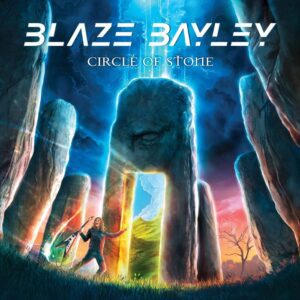In the vibrant world of rock, epic battles between giants have never been solely about sound power or dazzling stages. Sometimes, the most significant conflicts are waged in the subtle contrasts between the enormity of an artistic project and the pure, Spartan passion fueling a more humble work. This is the backdrop for a clash between two titans of music: Bruce Dickinson and Blaze Bayley, both united by Iron Maiden yet distinct in their solo journeys. The two vocalists find themselves releasing their solo works almost simultaneously—a coincidence that nevertheless sparks comparison, but mind you, this isn’t meant to start off as a merciless contest.
 On one side, we have Bruce, the “Goliath,” whose new solo project, “The Mandrake Project,” stands as a colossus. It’s not just an album; it’s an artistic ecosystem that includes various editions of the record, a comic book, captivating graphics, and a distinctive logo. It’s a universe unto itself, rich in narrative and imagination, reflecting Dickinson’s ambition and the vast scope of his artistic vision.
On one side, we have Bruce, the “Goliath,” whose new solo project, “The Mandrake Project,” stands as a colossus. It’s not just an album; it’s an artistic ecosystem that includes various editions of the record, a comic book, captivating graphics, and a distinctive logo. It’s a universe unto itself, rich in narrative and imagination, reflecting Dickinson’s ambition and the vast scope of his artistic vision.
On the other side, Blaze Bayley, the “David” of our story, emerges. With his “Circle of Stone,” Blaze ventures not into the lands of gargantuan productions or cross-media universes.  Instead, he sticks to what he knows best: a more direct and Spartan approach to music. Without the pomp of extensive collaborations or multimedia narrative extensions, his project shines for its authenticity and the raw emotional connection it establishes with the listener. It’s the quintessence of art that speaks directly to the heart, without the need for embellishments.
Instead, he sticks to what he knows best: a more direct and Spartan approach to music. Without the pomp of extensive collaborations or multimedia narrative extensions, his project shines for its authenticity and the raw emotional connection it establishes with the listener. It’s the quintessence of art that speaks directly to the heart, without the need for embellishments.
This isn’t a comparison between two artists or two albums; it’s a reflection on the very nature of art and how it manifests in different ways. While Dickinson’s project can be seen as an attempt to expand the boundaries of what an album can be, Bayley reminds us that, at the heart of music, what matters most is the emotional connection one can create with their audience. In this light, “David versus Goliath” becomes more than a metaphor; it’s a testament to the diversity of artistic expressions in the world of rock.
With this in mind, let’s delve deeper into the comparison, seeking to understand what these projects tell us about the meaning of art and its ability to connect people in surprisingly different ways.
 Bruce Dickinson’s eclecticism, so vividly characterizing “The Mandrake Project,” goes beyond the mere musical experience; it extends further, enriching the album with a variety of content that amplifies the listening experience. Dickinson, with his intrinsic nature as a showman and his deep passion for theater, cinema, and literature, is not content with offering just musical tracks. He transforms the album into a veritable narrative universe, an artistic ecosystem that transcends the traditional format we’re accustomed to. Dickinson’s theatrical and narrative influences manifest in every aspect of the project. Each track is not merely a song but an act in a broader performance, a piece of a narrative puzzle that the listener is invited to put together. This approach not only enriches the musical experience but also creates a deeper bond between the artist and their audience, inviting listeners to immerse themselves in a world built not only of notes and chords but also of stories and characters. Beyond the music, “The Mandrake Project” is amplified by the addition of multimedia content such as comics, videos, and merchandise that expand the album’s universe. These additional elements are not mere promotional gimmicks but integral parts of the overall artistic experience, designed to further immerse the listener in Dickinson’s aesthetic and mythology. However, this abundance of content and the wide range of influences can sometimes lead to a sense of déjà vu, a familiarity that emerges in some parts of the album. The challenge for an eclectic artist like Dickinson lies in balancing innovation with consistency, in finding that sweet spot where the new and the bold blend harmoniously with echoes of the musical past. In “The Mandrake Project,” Dickinson navigates this fine line, offering moments of brilliant originality alongside tracks that resonate with the echo of past influences. Despite these occasional resonances with the familiar, the ambition and scope of Dickinson’s project are undeniable. “The Mandrake Project” stands not only as an album but as a celebration of art in multiple forms, a testament to Dickinson’s ongoing evolution as an artist and storyteller. Through this project, he invites his audience to explore new artistic horizons with him, demonstrating that even amidst the familiar, there can be room for innovation and surprise.
Bruce Dickinson’s eclecticism, so vividly characterizing “The Mandrake Project,” goes beyond the mere musical experience; it extends further, enriching the album with a variety of content that amplifies the listening experience. Dickinson, with his intrinsic nature as a showman and his deep passion for theater, cinema, and literature, is not content with offering just musical tracks. He transforms the album into a veritable narrative universe, an artistic ecosystem that transcends the traditional format we’re accustomed to. Dickinson’s theatrical and narrative influences manifest in every aspect of the project. Each track is not merely a song but an act in a broader performance, a piece of a narrative puzzle that the listener is invited to put together. This approach not only enriches the musical experience but also creates a deeper bond between the artist and their audience, inviting listeners to immerse themselves in a world built not only of notes and chords but also of stories and characters. Beyond the music, “The Mandrake Project” is amplified by the addition of multimedia content such as comics, videos, and merchandise that expand the album’s universe. These additional elements are not mere promotional gimmicks but integral parts of the overall artistic experience, designed to further immerse the listener in Dickinson’s aesthetic and mythology. However, this abundance of content and the wide range of influences can sometimes lead to a sense of déjà vu, a familiarity that emerges in some parts of the album. The challenge for an eclectic artist like Dickinson lies in balancing innovation with consistency, in finding that sweet spot where the new and the bold blend harmoniously with echoes of the musical past. In “The Mandrake Project,” Dickinson navigates this fine line, offering moments of brilliant originality alongside tracks that resonate with the echo of past influences. Despite these occasional resonances with the familiar, the ambition and scope of Dickinson’s project are undeniable. “The Mandrake Project” stands not only as an album but as a celebration of art in multiple forms, a testament to Dickinson’s ongoing evolution as an artist and storyteller. Through this project, he invites his audience to explore new artistic horizons with him, demonstrating that even amidst the familiar, there can be room for innovation and surprise.
 “Circle of Stone” by Blaze Bayley, with its powerful emotional charge, represents a fascinating counterpoint to the ambitious project of his legendary counterpart. While the latter can be described as an artistic universe unto itself, full of variety and spectacle, Bayley’s work stands out for its genuineness and an intimacy that touches the soul directly and unpretentiously. The strength of “Circle of Stone” lies in its disarming sincerity. Blaze, through his work, does not seek to build an imaginary world rich with multimedia elements but rather to dig deep into the human experience, exploring universal themes such as struggle, resilience, and personal redemption. His songs act as a mirror to internal battles, offering listeners catharsis through the sharing of deep and sometimes dark emotions. Have we heard this in “War Within Me”? Perhaps, but let’s remember that before this album, Blaze had to deal with a serious heart attack, which I believe influenced the album’s composition. The musical arrangements in “Circle of Stone” amplify this emotional connection. Bayley’s music does not hide behind complexity or grandiosity; rather, it focuses on sincere melodies and a sound that, while powerful, prioritizes expressive clarity. This artistic choice makes the album intensely enjoyable, allowing Bayley’s message and passion to resonate clearly without distractions. Furthermore, the genuineness of “Circle of Stone” is manifested in its thematic and stylistic coherence. Each track contributes to weaving a consistent emotional fabric, making the listening experience a complete and enriching journey. This cohesion contrasts with the wide range of experiences offered by “The Mandrake Project” and can be seen as a distinctive strength of Bayley’s work, which speaks directly to listeners’ hearts with a clear and deeply human voice. Despite seemingly being “defeated from the start” by the buzz surrounding Dickinson’s project, Bayley demonstrates that the power of music lies not only in the grandeur of production but also in the ability to touch the most intimate chords of the human soul. Bayley’s work emerges not only as intensely genuine but also as extremely enjoyable, offering an emotional refuge and a human response to the often overwhelming dynamism of the modern world.
“Circle of Stone” by Blaze Bayley, with its powerful emotional charge, represents a fascinating counterpoint to the ambitious project of his legendary counterpart. While the latter can be described as an artistic universe unto itself, full of variety and spectacle, Bayley’s work stands out for its genuineness and an intimacy that touches the soul directly and unpretentiously. The strength of “Circle of Stone” lies in its disarming sincerity. Blaze, through his work, does not seek to build an imaginary world rich with multimedia elements but rather to dig deep into the human experience, exploring universal themes such as struggle, resilience, and personal redemption. His songs act as a mirror to internal battles, offering listeners catharsis through the sharing of deep and sometimes dark emotions. Have we heard this in “War Within Me”? Perhaps, but let’s remember that before this album, Blaze had to deal with a serious heart attack, which I believe influenced the album’s composition. The musical arrangements in “Circle of Stone” amplify this emotional connection. Bayley’s music does not hide behind complexity or grandiosity; rather, it focuses on sincere melodies and a sound that, while powerful, prioritizes expressive clarity. This artistic choice makes the album intensely enjoyable, allowing Bayley’s message and passion to resonate clearly without distractions. Furthermore, the genuineness of “Circle of Stone” is manifested in its thematic and stylistic coherence. Each track contributes to weaving a consistent emotional fabric, making the listening experience a complete and enriching journey. This cohesion contrasts with the wide range of experiences offered by “The Mandrake Project” and can be seen as a distinctive strength of Bayley’s work, which speaks directly to listeners’ hearts with a clear and deeply human voice. Despite seemingly being “defeated from the start” by the buzz surrounding Dickinson’s project, Bayley demonstrates that the power of music lies not only in the grandeur of production but also in the ability to touch the most intimate chords of the human soul. Bayley’s work emerges not only as intensely genuine but also as extremely enjoyable, offering an emotional refuge and a human response to the often overwhelming dynamism of the modern world.
Personal preference between these two solo masterpieces can vary significantly among listeners. For some, Dickinson’s bold experimentation in “The Mandrake Project” represents the pinnacle of rock art, an adventurous journey through uncharted sonic landscapes. For others, the raw emotionality and thematic consistency of Blaze’s “Circle of Stone” offer a deeper, more personal connection, a reflection of the struggles and victories that define the human experience. Personally? Blaze’s album felt much more “mine” compared to Bruce’s.
And you?


